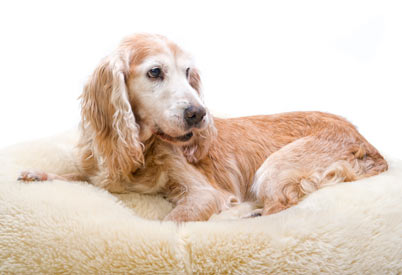Urinary Incontinence: Causes of Urine Leaking in Dogs

Urinary incontinence in dogs is a common problem that causes dogs to leak urine while they are resting, sleeping, or sometimes while walking. The urine leakage is unconscious. This means that the dog is not aware of the urine leaking until she sees it or feels it on her skin. Urinary incontinence in dogs can be frustrating for dog owners, who may think that their dog's housetraining has been forgotten, that she is purposely having accidents in the house out of spite, or that she has become senile. It is important to determine whether your dog is urinating consciously or unconsciously in order to diagnose incontinence. In general, if your pet's bed is wet after she gets out of it, or if you see urine dribbling out while she is walking and she does not seem to notice, your dog has urinary incontinence.
Causes of Urinary Incontinence in Dogs
- Urinary tract infection (UTI) can cause urinary incontinence in dogs. This is a bacterial infection of the urinary tract, usually the bladder. UTI causes irritation to the lining of the bladder and urethra and results in an increased urgency to urinate and possibly leaking of urine.
-
Overconsumption of water may cause urinary incontinence in dogs. This is due to the bladder being overfull and leaking. The causes of increased water consumption are many. The most common include:
- Diabetes mellitus
- Cushing's syndrome
- Kidney failure
- Urinary tract infection
- Spinal cord disease can cause urinary incontinence in dogs. This may be severe arthritis or a ruptured or herniated disc. Compression of the nerves that control bladder function results in the inability to hold urine.
-
A weak bladder sphincter causes urinary incontinence in dogs. This can be the result of several things, including:
- Obesity.
- Aging.
- Decreased sensitivity of certain neurologic receptors in the bladder. This may have to do with a lack of estrogen in spayed female dogs, as they are more prone to urinary incontinence that responds to estrogen treatment.
Breeds, Gender, and Age Most Commonly Affected by Urinary Incontinence in Dogs
- There is no breed predilection for urinary incontinence in dogs.
- Dogs of all ages may be affected by urinary incontinence, depending on the cause. Urinary tract infection can cause incontinence in all ages. Sphincter weakness is more common in middle-aged to older dogs.
- Females are more prone to urinary incontinence caused by urinary tract infection or sphincter weakness. The other causes of urinary incontinence are not more common to either gender.
Diagnosis of Urinary Incontinence in Dogs
- Urinalysis: a multi-faceted test of your dog's urine that will reveal signs of infection such as the presence of white blood cells, red blood cells, and bacteria. It also includes a specific gravity test. This will reveal whether the dog is drinking more water than normal.
- Urine Culture: a test where any bacteria found in the urine are encouraged to multiply on a petri dish so they can be identified. Then, the bacteria are challenged by different antibiotics to find out which ones will probably work to clear the infection in the dog.
- Blood Panel: this test is done if the urinalysis reveals a need for it. For example, if excess sugar is found during the urinalysis and the specific gravity is low, a blood panel will be run to see if blood sugar is also elevated, indicating that the dog has diabetes mellitus.
Treatment of Urinary Incontinence in Dogs
Successfully treating urinary incontinence in dogs hinges on properly diagnosing its cause.
- Urinary tract infection is treated with the appropriate antibiotic.
- Spinal cord disease is treated with medications, rest, and sometimes decompression surgery.
-
A weak bladder sphincter is treated in one or more of the following ways:
- Estrogens: The most common estrogen used to treat urinary incontinence in dogs is diethylstilbestrol, or DES. Treatment is started daily and then is weaned down to the lowest effective dose, usually once or twice a week. Estrogens can have bone marrow suppression side effects if they are used at high doses for long periods of time.
- Phenylpropanolamine, or Proin: This drug is quite effective in treating many cases of urinary incontinence in dogs. There are very few negative side effects, but it should not be used in dogs with high blood pressure, diabetes, or glaucoma or those on certain other medications.
- Combination: Some dogs require a combination of DES and Proin to control their incontinence.
- Surgery: There are several surgical techniques that may help dogs with urinary incontinence. Sometimes surgery alone is helpful, but other times medication is needed following surgery. Dogs that were not previously helped by medication may become continent on medication following surgery.
Never punish your dog for urinary incontinence. It is a medical problem that your dog cannot control, and punishment is not appropriate.
Never give your dog any medications without checking with your veterinarian first.
Home Care for Urinary Incontinence in Dogs
Because urinary incontinence can be a frustrating problem for dog-owners, it is important to take your dog to the veterinarian when it first begins. Some owners assume that the condition is due to aging and is not treatable. They become more and more frustrated and sometimes choose euthanasia. There are some things that you can do to minimize the frustrating nature of incontinence in dogs that are not made completely continent through treatments.
- Diapers and pads: There are diapers available for male and female dogs. Disposable pads used in dog beds and other areas that your dog rests can mitigate urine messes. It is important to change diapers and pads often and ensure that your dog's skin isn't staying moist.
- A female dog that is leaking urine, especially an overweight dog, may need to have the area around her vulva cleaned and dried daily to avoid skin infections that may, in turn, ascend and become urinary tract infections.
Prevention of Urinary Incontinence in Dogs
There is no way to prevent urinary incontinence in dogs, but it is important to visit the veterinarian as soon as it begins in order to properly diagnose and treat the cause.
Prognosis for Urinary Incontinence in Dogs
The prognosis for urinary incontinence is excellent when the cause is urinary tract infection and it is properly treated. Sphincter weakness is very commonly managed quite well with proper medications. The other causes of urinary incontinence carry their own individual prognoses.
Alternative Therapies for Urinary Incontinence in Dogs
- Acupuncture is sometimes used in the treatment of urinary incontinence in dogs.
- Chiropractic manipulation is sometimes used for dogs with urinary incontinence, but its use is controversial among veterinarians and may result in worsening of the condition or the development of new conditions. Always be sure to discuss this and any treatment with your veterinarian before proceeding.
New and Cutting-Edge Therapies and Treatments
Collagen injections into the urethra have shown promise in treating some dogs that do not respond to the medical treatment of urinary incontinence in dogs.
You May Also Like These Articles:
Causes of Frequent Urination and Urinary Accidents in Dogs
Disclaimer: This website is not intended to replace professional consultation, diagnosis, or treatment by a licensed veterinarian. If you require any veterinary related advice, contact your veterinarian promptly. Information at DogHealth.com is exclusively of a general reference nature. Do not disregard veterinary advice or delay treatment as a result of accessing information at this site. Just Answer is an external service not affiliated with DogHealth.com.
Notice: Ask-a-Vet is an affiliated service for those who wish to speak with a veterinary professional about their pet's specific condition. Initially, a bot will ask questions to determine the general nature of your concern. Then, you will be transferred to a human. There is a charge for the service if you choose to connect to a veterinarian. Ask-a-Vet is not manned by the staff or owners of DogHealth.com, and the advice given should not delay or replace a visit to your veterinarian.


